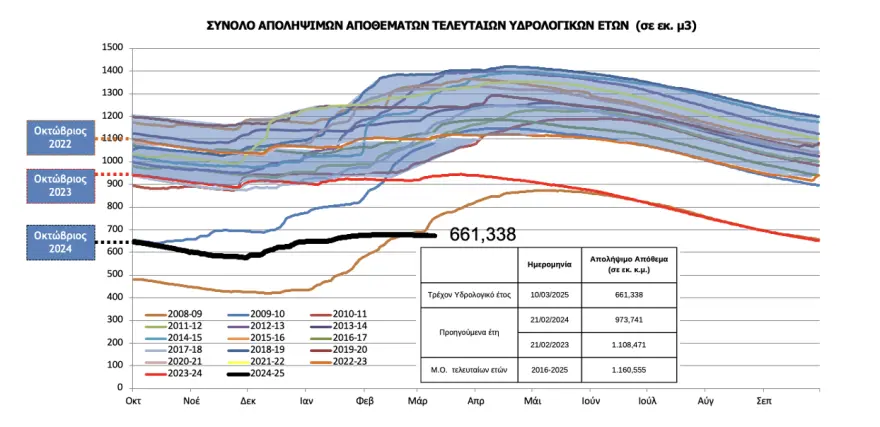A Declining Trend in Water Reserves
According to the Athens Water Supply and Sewerage Company (EYDAP), the drop in Marathon Lake’s water level is not necessarily a direct indicator of drought, as the reservoir’s management is closely linked to the overall External Water Supply System. However, a broader assessment of all reservoirs in the region paints a more concerning picture—water reserves are steadily declining, necessitating additional measures to ensure Attica’s water security.

The emergence of the islet is a visible symptom of the pressures on the region’s water supply system. This phenomenon, combined with data showing a downward trend in reserves, underscores the urgency of implementing more effective water management strategies to mitigate the impacts of water scarcity.
Water Reserves at Record Lows
Recent data obtained by protothema.gr reveals that Attica’s available water reserves have reached critically low levels. As of March 10, 2025, usable reserves stood at 661.3 million cubic meters—the lowest recorded in recent years. Comparatively, on February 21, 2024, reserves were significantly higher at 973.7 million cubic meters, marking a drastic decline of 312 million cubic meters within just one year. In 2023, reserves were at 1.1 billion cubic meters, demonstrating a staggering loss of nearly 450 million cubic meters by 2025.
The average water reserve levels from 2016 to 2025 stand at 1.16 billion cubic meters, making this year’s drastic reduction particularly alarming. Graphical data highlights the severity of the situation, with the current hydrological year’s trendline sitting well below previous years, indicating a sharp and ongoing decline.
These figures reflect a pressing challenge for Attica’s water supply, as prolonged drought conditions have played a significant role in depleting reserves. Without decisive action, water scarcity could become a growing threat for the region’s residents.
Measures to Address the Crisis
In response, the Greek government and EYDAP have outlined an ambitious plan to tackle the crisis, focusing on both immediate interventions and long-term solutions. The strategy includes:
- Expanding water resources by interconnecting the Krikeliótis and Karpenisiotis rivers with the Evinos reservoir to reinforce Attica’s supply.
- Reactivating and upgrading groundwater wells in Mavrosouvala while fully operationalizing pumping stations in Yliki.
- Exploring alternative water sources, including brackish water extraction near the Mornos aqueduct and desalination of seawater—feasibility studies for which are already underway.
- Emergency measures, such as transporting water from the Acheloos River via specialized tankers if infrastructure projects face delays.
Additionally, public awareness campaigns are being intensified, encouraging water conservation practices and the increased use of untreated or recycled water where feasible.
A Call for Sustainable Water Management
The sight of a newly emerged rocky islet in Marathon Lake serves as a stark visual reminder of the growing strain on Attica’s water supply. While EYDAP assures that it has the expertise and infrastructure to manage the situation, the ongoing climate crisis demands a more proactive and sustainable approach to water resource management. The data is clear—without urgent action, water scarcity could become a long-term reality for the region.
Ask me anything
Explore related questions





